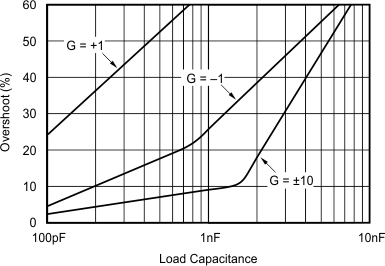SBOS054B January 1995 – September 2015 OPA132 , OPA2132 , OPA4132
PRODUCTION DATA.
- 1 Features
- 2 Applications
- 3 Description
- 4 Revision History
- 5 Pin Configuration and Functions
- 6 Specifications
- 7 Detailed Description
- 8 Application and Implementation
- 9 Power Supply Recommendations
- 10Layout
- 11Device and Documentation Support
- 12Mechanical, Packaging, and Orderable Information
Package Options
Mechanical Data (Package|Pins)
- D|8
Thermal pad, mechanical data (Package|Pins)
- D|8
Orderable Information
6 Specifications
6.1 Absolute Maximum Ratings
over operating free-air temperature range (unless otherwise noted) (1)| MIN | MAX | UNIT | ||
|---|---|---|---|---|
| Supply voltage, V+ to V– | 36 | V | ||
| Input voltage | (V–) –0.7 | (V+) +0.7 | V | |
| Output short-circuit(2) | Continuous | |||
| Operation temperature | –40 | 125 | °C | |
| Junction temperature | 150 | °C | ||
| Tstg | Storage temperature | –55 | 125 | °C |
(1) Stresses beyond those listed under Absolute Maximum Ratings may cause permanent damage to the device. These are stress ratings only, which do not imply functional operation of the device at these or any other conditions beyond those indicated under Recommended Operating Conditions. Exposure to absolute-maximum-rated conditions for extended periods may affect device reliability.
(2) Short-circuit to ground, one amplifier per package.
6.2 ESD Ratings
| VALUE | UNIT | |||
|---|---|---|---|---|
| OPA132 in PDIP and SOIC Package, OPA2132 and OPA4132 in PDIP Package | ||||
| V(ESD) | Electrostatic discharge | Human-body model (HBM), per ANSI/ESDA/JEDEC JS-001(1) | ±2000 | V |
| OPA2132 in SOIC Package | ||||
| V(ESD) | Electrostatic discharge | Human-body model (HBM), per ANSI/ESDA/JEDEC JS-001(1) | ±2000 | V |
| Charged-device model (CDM), per JEDEC specification JESD22-C101(2) | ±500 | |||
| OPA4132 in SOIC Package | ||||
| V(ESD) | Electrostatic discharge | Human-body model (HBM), per ANSI/ESDA/JEDEC JS-001(1) | ±2000 | V |
| Charged-device model (CDM), per JEDEC specification JESD22-C101(2) | ±200 | |||
(1) JEDEC document JEP155 states that 500-V HBM allows safe manufacturing with a standard ESD control process.
(2) JEDEC document JEP157 states that 250-V CDM allows safe manufacturing with a standard ESD control process.
6.3 Recommended Operating Conditions
over operating free-air temperature range (unless otherwise noted)| MIN | NOM | MAX | UNIT | ||
|---|---|---|---|---|---|
| VS | Supply voltage, VS = (V+) – (V–) | ±2.5 | ±15 | ±18 | V |
| TA | Specified temperature range | –40 | 85 | °C | |
6.4 Electrical Characteristics
At TA = 25°C, VS = ±15 V, unless otherwise noted.| PARAMETER | TEST CONDITIONS | OPAx132P, U OPA2132P, U |
OPAx132PA, UA OPA2132PA, UA OPA4132PA, UA |
UNIT | |||||||
|---|---|---|---|---|---|---|---|---|---|---|---|
| MIN | TYP | MAX | MIN | TYP | MAX | ||||||
| OFFSET VOLTAGE | |||||||||||
| Input Offset Voltage | ±0.25 | ±0.5 | ±0.5 | ±2 | mV | ||||||
| vs Temperature(1) | Operating temperature range | ±2 | ±10 | ±2 | ±10 | µV/°C | |||||
| vs Power Supply | VS = ±2.5 V to ±18 V | 5 | 15 | 5 | 30 | µV/V | |||||
| Channel Separation (dual and quad) | RL = 2 kΩ | 0.2 | 0.2 | µV/V | |||||||
| INPUT BIAS CURRENT | |||||||||||
| Input Bias Current(2) | VCM = 0 V | 5 | ±50 | 5 | ±50 | pA | |||||
| vs Temperature | See Figure 5 | See Figure 5 | |||||||||
| Input Offset Current(2) | VCM = 0 V | ±2 | ±50 | ±2 | ±50 | pA | |||||
| NOISE | |||||||||||
| Input Voltage Noise | |||||||||||
| Noise Density | f = 10 Hz | 23 | 23 | nV/√Hz | |||||||
| f = 100 H | 10 | 10 | |||||||||
| f = 1 kHz | 8 | 8 | |||||||||
| f = 10 kHz | 8 | 8 | |||||||||
| Current Noise Density, |
f = 1 kHz | 3 | 3 | fA/√Hz | |||||||
| INPUT VOLTAGE RANGE | |||||||||||
| Common-Mode Voltage Range | (V–) +2.5 |
±13 | (V+) –2.5 |
(V–) +2.5 |
±13 | (V+) –2.5 |
V | ||||
| Common-Mode Rejection | VCM = –12.5 V to 12.5 V | 96 | 100 | 86 | 94 | dB | |||||
| INPUT IMPEDANCE | |||||||||||
| Differential | 1013 || 2 | 1013 || 2 | Ω || pF | ||||||||
| Common-Mode | VCM = –12.5 V to 12.5 V | 1013 || 6 | 1013 || 6 | Ω || pF | |||||||
| OPEN-LOOP GAIN | |||||||||||
| Open-Loop Voltage Gain | RL = 10 kΩ, VO = –14.5 V to 13.8 V |
110 | 120 | 104 | 120 | dB | |||||
| RL = 2 kΩ, VO = –13.8 V to 13.5 V |
110 | 126 | 104 | 120 | |||||||
| RL = 600 Ω, VO = –12.8 V to 12.5 V |
110 | 130 | 104 | 120 | |||||||
| FREQUENCY RESPONSE | |||||||||||
| Gain-Bandwidth Product | 8 | 8 | MHz | ||||||||
| Slew Rate | ±20 | ±20 | V/µs | ||||||||
| Settling Time: | 0.1% | G = –1, 10 V Step, CL = 100 pF |
0.7 | 0.7 | µs | ||||||
| 0.01% | G = –1, 10 V Step, CL = 100 pF |
1 | 1 | µs | |||||||
| Overload Recovery Time | G = ± | 0.5 | 0.5 | µs | |||||||
| Total Harmonic Distortion + Noise | 1 kHz, G = 1, VO = 3.5 Vrms |
RL = 2 kΩ | 0.00008% | 0.00008% | |||||||
| RL = 600 Ω | 0.00009% | 0.00009% | |||||||||
| OUTPUT | |||||||||||
| Voltage Output | Positive | RL = 10 kΩ | (V+) –1.2 |
(V+) –0.9 |
(V+) –1.2 |
(V+) –0.9 |
V | ||||
| Negative | (V–) +0.5 |
(V–) +0.3 |
(V–) +0.5 |
(V–) +0.3 |
|||||||
| Positive | RL= 2 kΩ | (V+) –1.5 |
(V+) –1.1 |
(V+) –1.5 |
(V+) –1.1 |
||||||
| Negative | (V–) +1.2 |
(V–) +0.9 |
(V–) +1.2 |
(V–) +0.9 |
|||||||
| Positive | RL = 600 Ω | (V+) –2.5 |
(V+) –2.0 |
(V+) –2.5 |
(V+) –2.0 |
||||||
| Negative | (V–) +2.2 |
(V–) +1.5 |
(V–) +2.2 |
(V–) +1.5 |
|||||||
| Short-Circuit Current | ±40 | ±40 | mA | ||||||||
| Capacitive Load Drive (Stable Operation) | See Figure 17 | See Figure 17 | |||||||||
| POWER SUPPLY | |||||||||||
| Specified Operating Voltage | ±15 | ±15 | V | ||||||||
| Operating Voltage Range | ±2.5 | ±18 | ±2.5 | ±18 | V | ||||||
| Quiescent Current (per amplifier) |
IO = 0 | ±4 | ±4.8 | ±4 | ±4.8 | mA | |||||
| TEMPERATURE RANGE | |||||||||||
| Operating Range | –40 | 85 | –40 | 85 | °C | ||||||
| Storage | –40 | 125 | –40 | 125 | °C | ||||||
(1) Specified by wafer test.
(2) High-speed test at TJ = 25°C.
6.5 Typical Characteristics
At TA = 25°C, VS = ±15 V, RL = 2 kΩ, unless otherwise noted.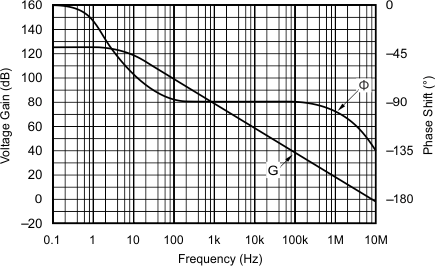
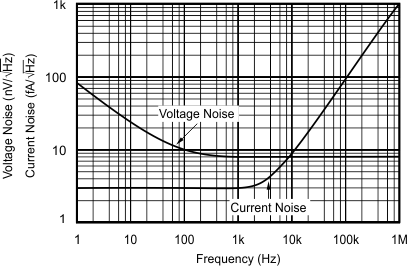
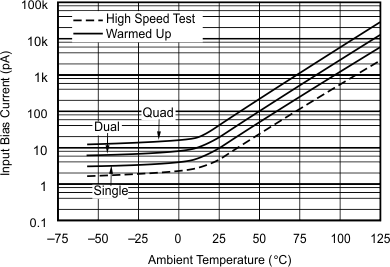
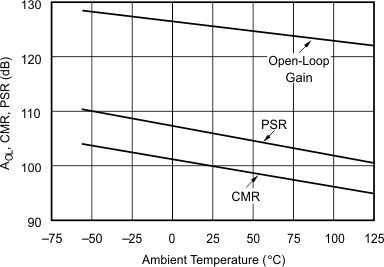
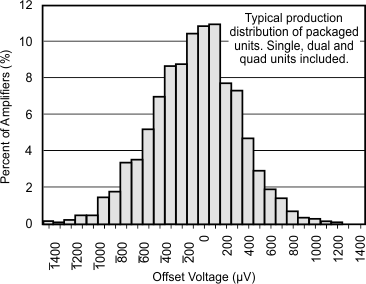
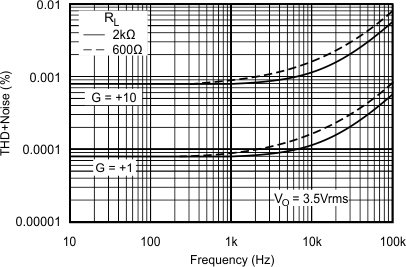
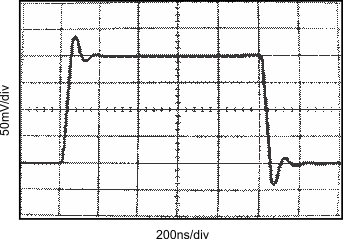
| G = 1 | CL = 100pF |
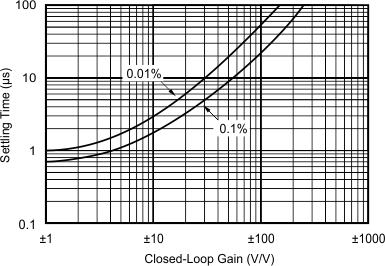
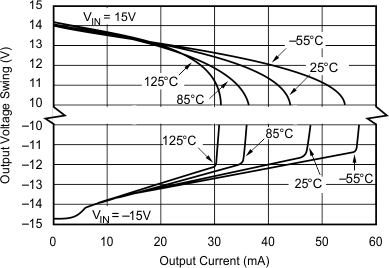
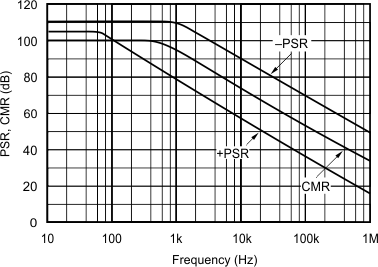
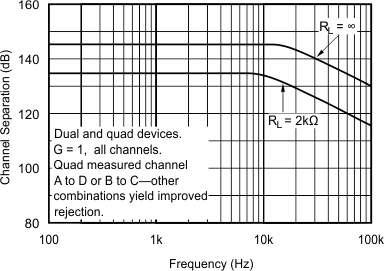
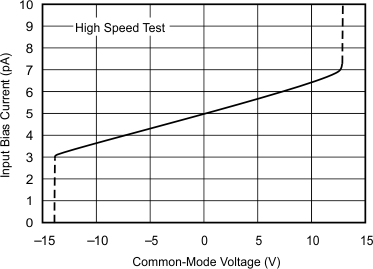
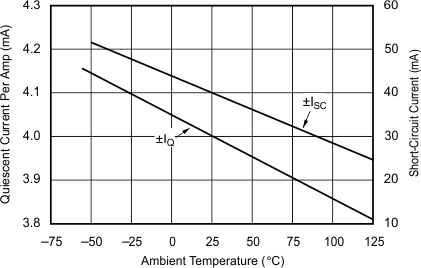
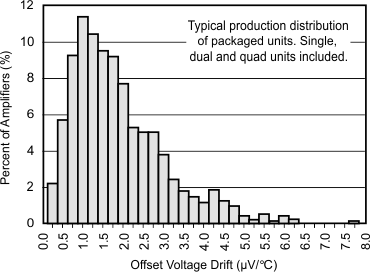
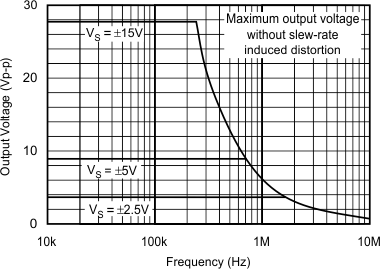
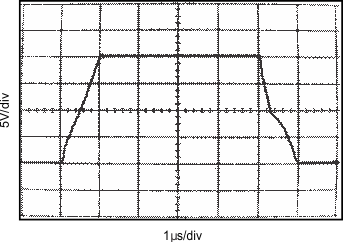
| G = 1 | CL = 100pF |
